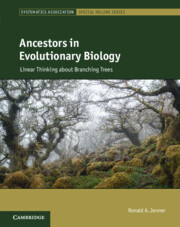Book contents
- Ancestors in Evolutionary Biology
- The Systematics Association Special Volume Series
- Ancestors in Evolutionary Biology
- Copyright page
- Dedication
- Contents
- Acknowledgments
- 1 A History of Narrative Phylogenetics
- 2 From Archetypes to Ancestors
- 3 The Emergence of Lineage Thinking
- 4 Ernst Haeckel’s Evolutionary Storytelling
- 5 The Epistemic Rise of Hypothetical Ancestors
- 6 Intuiting Evolution
- 7 Telling Straight Stories with Fossils
- 8 Seeing Animal Ancestors in Embryos
- 9 Ancestral Attractions and Phylogenetic Folklore
- 10 Narrative Shortcuts and Phylogenetic Faux Pas
- 11 Taxic Distortions of Lineage Thinking
- 12 Making Sense with Stories
- References
- Index
- Systematics Association Special Volumes
9 - Ancestral Attractions and Phylogenetic Folklore
Published online by Cambridge University Press: 08 July 2022
- Ancestors in Evolutionary Biology
- The Systematics Association Special Volume Series
- Ancestors in Evolutionary Biology
- Copyright page
- Dedication
- Contents
- Acknowledgments
- 1 A History of Narrative Phylogenetics
- 2 From Archetypes to Ancestors
- 3 The Emergence of Lineage Thinking
- 4 Ernst Haeckel’s Evolutionary Storytelling
- 5 The Epistemic Rise of Hypothetical Ancestors
- 6 Intuiting Evolution
- 7 Telling Straight Stories with Fossils
- 8 Seeing Animal Ancestors in Embryos
- 9 Ancestral Attractions and Phylogenetic Folklore
- 10 Narrative Shortcuts and Phylogenetic Faux Pas
- 11 Taxic Distortions of Lineage Thinking
- 12 Making Sense with Stories
- References
- Index
- Systematics Association Special Volumes
Summary
In this chapter I chronicle the emergence of different phylogenetic traditions in invertebrate zoology that coalesced around attractive hypothetical ancestors. The first half of the chapter discusses different scenarios for the origin of Bilateria that emerged in the late nineteenth and early twentieth centuries, including the enterocoel and archicoelomate theories, and the importance of the contested character of amphistomy for these scenarios. These scenarios became phylogenetic totems in different parts of the world, with Gastraea at the core of the European zoological tradition, and Phagocytella rooting both the Russian and American traditions. In the mid-twentieth century an alternative theory was proposed that derived bilaterians directly from ciliate ancestors. Remarkably, this attraction to ciliate ancestors emerged three times independently in quick succession, which illustrates the epistemic importance accorded to the precursor potential of hypothetical ancestors in narrative phylogenetic debates. The second half of the chapter discusses why many authors have felt so strongly attracted to annelid-like ancestors. These were proposed to have crawled at the cradles of many taxa, including molluscs, arthropods, vertebrates, and Bilateria. The arguments used to promote annelid-like ancestors form a conspicuous strand in the history of narrative phylogenetics, and it can still be traced today.
Keywords
- Type
- Chapter
- Information
- Ancestors in Evolutionary BiologyLinear Thinking about Branching Trees, pp. 242 - 281Publisher: Cambridge University PressPrint publication year: 2022

